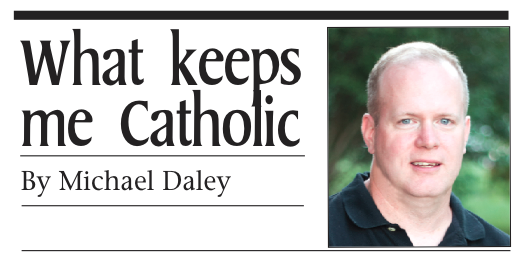New book examines Catholic symbols
Thursday, November 12, 2009
By Eileen Connelly, OSU
ARCHDIOCESE — Whether it’s the stained-glass windows with images of the saints that fill our churches with light, the crèche that powerfully celebrates the mystery of the incarnation or the eucharistic meal through which we become one with Christ and each other, our Catholic faith involves hundreds of symbols.
With the hope of giving readers greater appreciation and understanding of those symbols, Michael Daley, a religion teacher at St. Xavier High School has penned a new book, Our Catholic Symbols: A Rich Spiritual Heritage (Twenty-Third Publications, 2009).
 |
| Michael Daley, author of Our Catholic Symbols: A Rich Spiritual Heritage (Courtesy photo) |
“I think the symbols are what attracts people to the Catholic Church, at our best and our worse,” said Daley, a writer whose articles have appeared in publications such as U.S. Catholic, St. Anthony Messenger and the National Catholic Reporter. “It’s the core symbols like the crucifix, tabernacle, altar, holy water, bread and wine that draw us into the life of the church. There’s just something about the symbols that reminds us what it means to be Catholic.”
The concept for the book originated with a series of columns he wrote for Religion Teacher’s Journal, along with his desire as both a teacher and parent to provide an explanation for things. “The book is my humble attempt at that,” Daley said.
In the book he breaks down the physical and symbolic words of Catholic culture into the core symbols of Catholicism, including an explanation of the sacraments as the “living signs of Jesus’ love.” Also featured are symbolic persons from Scripture, including Adam and Eve, Noah, Abraham and Moses, and saints as symbolic persons, among them St. Elizabeth Ann Seton, as a symbol of God’s charity, and St. Patrick, symbol of a new life in Christ.
In addition, the book examine symbols of the Christian journey and symbols of the Mass, from an explanation to why Catholics sit, stand, kneel and genuflect when we do, to the simple, yet profound, symbol of the Sign of the Cross. Each chapter includes questions for reflection and review, activities for learners and suggestions for prayer.
Daley’s hope is that Our Catholic Symbols will not only be a rich resource for any Catholic interested in learning more about his or her faith, but also as a supplemental text for high school religion classes or use by catechists at the parish level.
“Symbols can be imparted in a variety of ways, but if you give people an understanding of symbols, you’re giving them their faith,” he said. “Part of the value of this book is that the one area where Catholics shouldn’t have any disagreement about their faith is about the core symbols. They root us in our faith and allow us to talk to each other. The beauty of symbols is that they touch us at the subconscious level. We’re not always aware of the impact they have on us.”
“I hope the book will help people better articulate their faith,” Daley added. “It’s written in a very simple, engaging way that will enable Catholics to explain the great symbols of our tradition to other people.”
Our Catholic Symbols is available at area bookstores or can be ordered from the publisher at http://www.pastoralplanning.com/.










